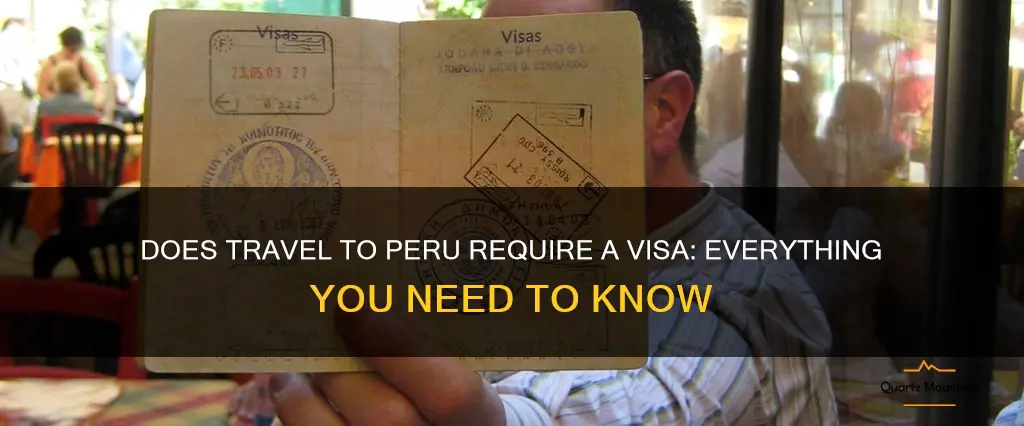
Peru, a land of stunning landscapes, ancient ruins, and rich cultural heritage, has become a popular destination for travelers from around the world. However, for those planning a trip to this South American gem, one question looms large: does travel to Peru require a visa? In this comprehensive guide, we will delve into everything you need to know about visa requirements for traveling to Peru, ensuring you have all the necessary information to make your journey to this vibrant country a seamless one. So pack your bags, as we embark on a journey to unravel the mysteries surrounding travel visas in Peru.
What You'll Learn

Traveling to Peru

If you're planning a trip to Peru, one of the first things you may be wondering is whether you need a visa to enter the country. The good news is that for many nationalities, including citizens of the United States, Canada, and the European Union, a visa is not required. However, there are some important details and exceptions to be aware of.
For citizens of most countries, including the United States, Canada, and the countries in the European Union, you can enter Peru as a tourist for up to 183 days without a visa. This means you can stay in Peru for nearly six months without needing any special permission.
It's important to note that this visa-free entry is only for tourism purposes. If you plan to work, study, or engage in any other type of activity in Peru, you will need to apply for a different type of visa. Additionally, the 183-day limit applies to the total time you spend in Peru within a single year. If you exceed this limit, you may face fines or other penalties upon departure.
While many nationalities can enter Peru without a visa, there are some exceptions. Citizens of certain countries, such as India, China, and Russia, do require a visa to enter Peru. If you are from one of these countries, you will need to apply for a visa at the nearest Peruvian consulate or embassy before your trip. The specific visa requirements and application process may vary depending on your nationality, so it's important to check with the consulate or embassy for the most up-to-date information.
When applying for a visa to enter Peru, you will generally need to provide the following documents:
- A valid passport with at least six months of validity remaining from the date of entry into Peru.
- A completed visa application form.
- Passport-sized photographs.
- Proof of travel arrangements, such as a round-trip airline ticket.
- Proof of accommodation in Peru, such as hotel reservations or a letter of invitation from a host.
It's worth noting that visa requirements can change, so it's always a good idea to check with the consulate or embassy before your trip to ensure you have the most current information. Remember to apply for your visa well in advance of your planned departure date, as processing times can vary.
In conclusion, if you're traveling to Peru as a tourist and hold a passport from the United States, Canada, or the countries in the European Union, you can enter Peru without a visa and stay for up to 183 days. However, if you are from a country that does require a visa, make sure to familiarize yourself with the requirements and allow enough time for the visa application process. Happy travels to Peru!
Exploring Travel Options: Can F-1 Visa Students Embark on Excursions to Hawaii?
You may want to see also

Visa-free entry for certain nationalities

Citizens of Visa-exempt countries enjoy the privilege of entering certain destinations without requiring a visa. This visa-free entry allows individuals to explore a country for a specific duration without the hassle of obtaining a visa in advance. However, it is important to understand the specifics of visa-free entry and the allowed length of stay, as regulations may vary from country to country.
Visa exemption means that the citizens of specific countries are permitted to enter a destination without having to go through the visa application process. This policy is typically based on diplomatic or trade agreements, bilateral relations, or regional cooperation among nations. It grants travelers the freedom to visit a country for tourism, business, or family visits for a predetermined period.
The length of stay without a visa varies depending on the destination and the purpose of the visit. In some cases, citizens of visa-exempt countries are allowed to stay for a certain number of days or weeks. For example, citizens of the United States can enjoy visa-free entry to many countries for up to 90 days within a 180-day period. This means that they can stay for up to 90 days within a six-month duration, but they must leave the country before the 90-day limit expires.
It is crucial to be aware of the length of stay permitted without a visa to avoid any complications or overstaying. Overstaying the designated period can lead to fines, deportation, or even being banned from entering the country in the future. Therefore, it is essential to carefully plan your itinerary and ensure compliance with the immigration regulations of the destination country.
To determine the length of stay without a visa, travelers should check the official website of the destination country's embassy or consulate. These governmental websites provide accurate and up-to-date information regarding visa requirements, including visa exemption policies and the allowed duration of stay. Additionally, travel agencies or professional immigration consultants can offer guidance and assistance in understanding the specific regulations of each country.
When traveling under visa exemption, it is essential to carry the required travel documents, such as a valid passport, proof of sufficient funds, and a return or onward ticket. Some countries may also require specific documents, such as an invitation letter, travel insurance, or proof of accommodation during the stay. It is advisable to review the necessary requirements before traveling to ensure a smooth and hassle-free experience at immigration checkpoints.
In conclusion, citizens of visa-exempt countries can enjoy visa-free entry to various destinations. However, it is vital to be aware of the length of stay allowed without a visa. Understanding the specific regulations, checking the embassy or consulate websites, and carrying the necessary documents are crucial steps to ensure a successful and legal visit. Travelers should always respect the immigration laws and avoid overstaying to avoid any negative consequences.
Planning Your Next Adventure: Traveling with a Permanent Visa Expiring in 2 Months
You may want to see also

Visa requirements for other nationalities

If you're planning to travel abroad as a tourist, it's essential to understand the visa requirements for your destination country. This guide will walk you through the tourist visa application process, the required documents you'll need to submit, and provide information on visa fees and processing time.
Tourist Visa Application Process:
To apply for a tourist visa, you'll generally need to follow these steps:
- Research and select the appropriate visa category: Start by understanding the different types of tourist visas available for your destination country. Some countries may have specific visas for tourism, while others may have a general visitor visa that covers both tourism and other short-term purposes. Check the official website of the consulate or embassy for detailed information on visa categories.
- Complete the visa application form: Once you've identified the correct visa category, download the visa application form from the official website. Fill out the form accurately and ensure that all information is complete and up to date. Some countries may require an online application submission, while others may accept physical forms.
- Gather the required documents: Check the official website of the consulate or embassy for a list of documents required for a tourist visa application. Commonly requested documents include a valid passport, passport-sized photographs, proof of travel arrangements (such as flight itineraries or hotel reservations), proof of financial stability, and a cover letter explaining the purpose of your trip.
- Submit your application: Once you've completed the visa application form and gathered all required documents, submit your application to the appropriate consulate or embassy. Some countries may require an in-person appointment, while others may accept applications via mail or online submission. Make sure to follow the specific instructions provided by the embassy or consulate.
- Pay the visa fees: Most countries charge a fee for processing tourist visa applications. Check the official website or contact the consulate or embassy to determine the correct visa fees. Be prepared to pay the fee either in cash, through a bank transfer, or online, depending on the country's requirements.
- Book an interview appointment (if necessary): Depending on the country, you may need to schedule an interview with a consular officer. The purpose of the interview is to verify the information provided in your application and ensure that you meet the requirements for a tourist visa. Follow the instructions provided by the consulate or embassy to schedule your interview, if applicable.
- Wait for visa processing: After submitting your application and attending the interview (if required), you'll need to be patient while your visa is processed. The processing time can vary depending on the destination country and the volume of applications being received. During this period, avoid making any non-refundable travel arrangements until your visa has been approved and issued.
Required Documents for a Tourist Visa:
The specific documents required for a tourist visa application may vary depending on the country. However, some common documents include:
- Valid passport with a minimum of six months' validity beyond your planned departure date.
- Passport-sized photographs meeting the embassy's specifications.
- Completed visa application form.
- Proof of travel arrangements, such as flight itineraries or hotel reservations.
- Proof of sufficient funds to cover your expenses during the trip, such as bank statements or sponsorship letters.
- Travel health insurance, if required.
- Invitation letters (if applicable).
- Cover letter explaining the purpose of your trip and your itinerary.
Make sure to carefully read the instructions provided by the consulate or embassy to ensure you submit all the required documents.
Visa Fees and Processing Time:
Visa fees for a tourist visa can vary greatly, ranging from a few dollars to several hundred dollars, depending on the destination country and visa category. Consult the official website of the consulate or embassy for accurate information on visa fees.
As for processing time, it can take anywhere from a few days to several weeks, depending on the country and the consulate's workload. Plan your application well in advance to avoid any last-minute complications or delays. Moreover, ensure that your passport has ample validity remaining, as visa applications may be rejected if your passport is close to expiration.
Understanding the tourist visa application process, the required documents, and the associated fees and processing time is crucial when planning your trip abroad. By following the steps outlined in this guide and carefully reviewing the consulate or embassy's instructions, you'll be well-prepared for your tourist visa application. Remember to start the process early and allow sufficient time for visa processing to avoid any unnecessary stress or complications.
Discovering Turkey: Navigating Transit Visa Requirements for Travelers
You may want to see also

Important considerations for traveling to Peru

Peru is a fascinating country with a rich history and diverse culture. It offers breathtaking landscapes, ancient ruins, and vibrant cities that attract tourists from all over the world. If you are planning a trip to Peru, there are a few important considerations to keep in mind to ensure a smooth and enjoyable journey. In this article, we will discuss other entry requirements, extension of stay in Peru, and provide some additional tips and recommendations for your trip.
Other entry requirements:
In addition to a valid passport, travelers from most countries are required to obtain a tourist visa to enter Peru. This visa allows tourists to stay in the country for a maximum of 183 days in a one-year period. Keep in mind that the maximum duration of stay may vary depending on your country of citizenship, so it is essential to check the specific requirements before traveling.
To apply for a tourist visa, you will need to visit the nearest Peruvian embassy or consulate in your home country. The application process typically requires completing a visa application form, submitting a passport-sized photograph, providing proof of travel plans (such as a return ticket), and a copy of your passport. It is advisable to apply for the visa well in advance of your intended travel date to avoid any unnecessary delays.
Extension of stay in Peru:
If you wish to extend your stay in Peru beyond the maximum duration granted by the tourist visa, you will need to apply for an extension at the Immigration Office (Migraciones) in Peru. This process can be done online, by visiting the local office, or by engaging the services of a legal representative.
To apply for an extension, you will need to provide proof of your current visa, a completed application form, a valid passport, and any other supporting documents requested by the Immigration Office. Extensions are typically granted for up to 90 days, but it is advisable to apply at least two weeks before your current visa expires to allow for processing time.
Additional tips and recommendations:
- Currency: The official currency in Peru is the Peruvian Sol (PEN). It is recommended to carry some local currency with you as credit cards are not accepted everywhere, especially in smaller towns and rural areas. Additionally, it is advisable to notify your bank or credit card provider about your travel plans to avoid any issues with accessing your funds while abroad.
- Health and Safety: Before your trip, it is important to consult with a healthcare professional or travel clinic to ensure you are up to date on routine vaccinations and to discuss any specific health concerns for Peru. It is also recommended to purchase travel insurance that covers medical expenses and emergency evacuation. While traveling, take precautions such as staying hydrated, using insect repellent, and avoiding street food to minimize the risk of illnesses.
- Altitude sickness: Many popular tourist destinations in Peru, such as Cusco and Machu Picchu, are located at high altitudes. It is essential to acclimatize properly to avoid altitude sickness. Take it easy for the first few days, drink plenty of fluids, avoid alcohol, and consider taking medication prescribed by a healthcare professional, such as acetazolamide, to help prevent and alleviate symptoms.
- Transportation: Peru has a well-developed transportation network, including buses, trains, and domestic flights. It is advisable to book transportation tickets in advance, especially if you plan to travel during peak tourist seasons. When using public transportation, be cautious of your belongings and keep an eye on your personal belongings to prevent theft.
In conclusion, traveling to Peru requires careful planning and consideration of entry requirements, extending your stay, and other important tips. By following the guidelines provided in this article, you can ensure a memorable and enjoyable trip to this beautiful South American country. Remember to do your research, stay informed, and be prepared for any unexpected situations. Enjoy your journey and immerse yourself in the wonders of Peru!
Do You Need a Visa to Travel to Ecuador? Find Out Here!
You may want to see also
Frequently asked questions
Yes, most travelers are required to obtain a visa before traveling to Peru. The visa requirements vary depending on the purpose of your visit and the duration of your stay. However, citizens from certain countries, such as the United States, Canada, the European Union, and Australia, are exempt from obtaining a visa for tourism purposes. It is important to visit the official website of the Peruvian Embassy or consult with your local consulate to determine the specific visa requirements for your country.
If you are a citizen of a country exempt from obtaining a visa for tourism purposes, you can stay in Peru for up to 183 days within a 365-day period. This means you can spend nearly 6 months in Peru without a visa. However, it is important to note that this duration may be subject to change and it is always best to check with the Peruvian Embassy or your local consulate for the most up-to-date information.
Yes, it is possible to extend your stay in Peru if you initially entered as a tourist without a visa. However, this extension is limited and you will need to apply for it before your initial 183 days expire. The extension is usually granted for an additional 90 days, but it is subject to approval by the Peruvian immigration authorities. It is recommended to consult with the Peruvian immigration office or an immigration lawyer for guidance on the extension process and requirements.







